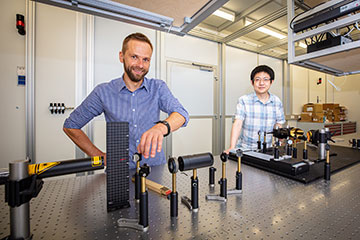
Together with their international colleagues, Dmitry Turchinovich (left) and Wentao Zhang demonstrate how the ultrafast change of magnetic states can be measured. [Image: M.-D. Müller, Bielefeld University]
Magnetism may seem to be a well-understood physical phenomenon by now, but scientists still have much to learn about the ultrafast changes in magnetic states that occur in the latest materials for data storage and computer memory.
Scientists from five countries have discovered that measuring the terahertz (THz) radiation generated by these sub-picosecond-scale flips provides a clear picture of the magnetization dynamics within these solid-state materials (Nat. Commun., doi: 10.1038/s41467-020-17935-6). The THz method reportedly works at ambient temperatures and realistic operating conditions for a memory device.
Spins and flips
Over the last two decades, scientists have intently studied the magnetic effects that happen when certain metals are excited with laser energy. These changes in spin momentum occur at timescales of less than 10–12 s. Some previous methods of tracking these flips required high-vacuum experimental conditions, while others provided ambiguous results. Scientists already knew that these sub-picosecond magnetic changes produce THz radiation, but teasing out the magnetization-based component and distinguishing it from the much-stronger electric dipole emission had been a challenge.
“As a physicist I am generally interested in fundamental properties of materials, and how they respond to external stimuli,” says Dmitry Turchinovich of Bielefeld University, Germany, who led the study. “Understanding the response of materials to excitations on an ultrafast timescale is of fundamental interest, and is also important for applications.”
Turchinovich and his team members, including Bielefeld graduate student and first author Wentao Zhang, placed a 10-nm-thick iron film between two layers of magnesium oxide and excited the stack with 100-fs, 800-nm laser pulses. The MgO lasers blocked the diffusion of hot electrons from the iron, thus eliminating the electric dipole emission driven by the inverse spin-Hall effect. The remaining THz radiation in the forward direction was combined with probe laser pulses in a beam splitter and detected by free-space optical sampling.
According to Turchinovich, the group’s biggest challenge was to reliably detect the magnetic dipole emission, because it was very weak—on the order of a few milliteslas. The team also performed extensive modeling to “accurately reconstruct our observable, ultrafast THz electromagnetic signal back to its origin, [and] the dynamics of magnetization in a laser-excited material,” he adds.
A surprise signal

This illustration shows how the researchers were able to measure the magnetization dynamics in the iron nanofilm caused by ultrafast electronic and acoustic processes. [Image: W. Zhang, Bielefeld University]
The team detected two components of the magnetization dynamics signal from the laser-excited iron. The first was the transient demagnetization driven by the direct excitation of electrons in iron. The researchers also noticed the secondary effect of ultrafast demagnetization, driven by the propagation of a very fast pulse of ultrasound in the sample. “This sound pulse originated from the ultrafast thermal expansion of the iron film, which followed the absorption of laser energy,” Turchinovich says.
“This magneto-acoustic signal came to us as quite a surprise—we did not expect it to be that strong and clear,” Turchinovich adds. “So I guess we will now try to better understand this ultrafast magnon–phonon interaction, both experimentally and theoretically.”
The team involved with this study included Eric Beaurepaire, a physicist from the University of Strasbourg, France, who conceived of the study along with Turchinovich, but died before the work was complete. Beaurepaire had studied ultrafast spin dynamics since the 1990s. Scientists from the Max Planck Institute for Polymer Research in Germany, Uppsala University in Sweden, University of Shanghai for Science and Technology in China, ETH Zurich in Switzerland, and the Free University of Berlin in Germany also contributed to the work.
